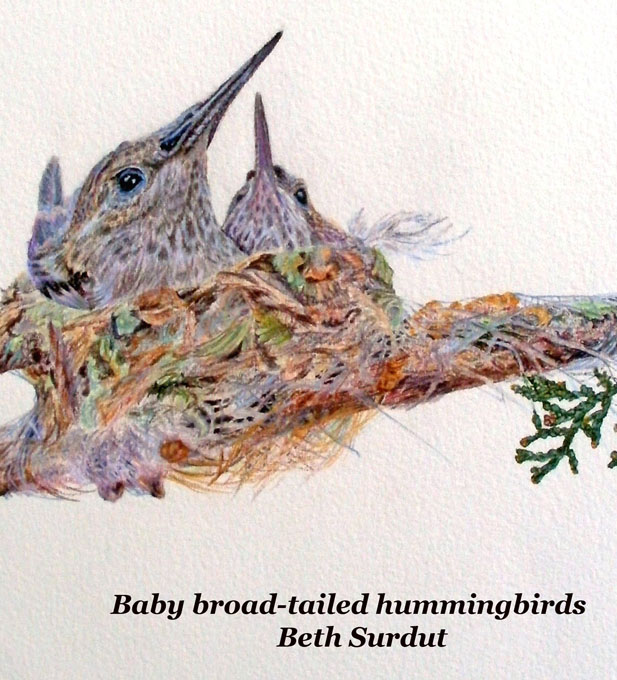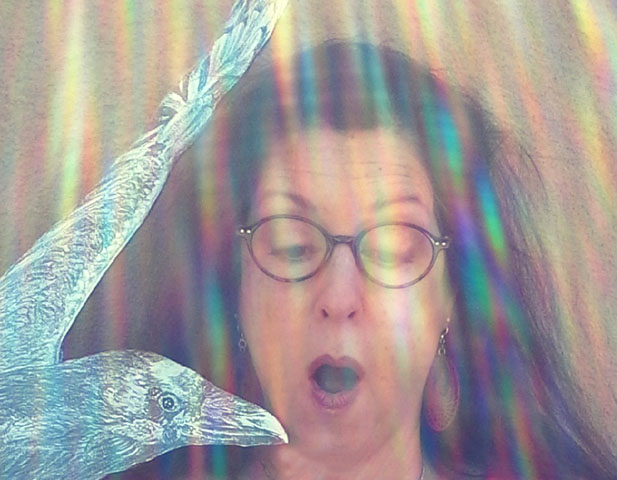Artist and writer Beth Surdut listens to ravens, and has paddled with alligators in wild and scenic places. She also knows about proper etiquette when encountering the smallest, fastest bird in the desert...
Listen:
The Art of Paying Attention: Hummingbird Etiquette
© Beth Surdut, 2016
This story starts with bird droppings. But before I go any further, if you have a penny and a quarter handy, please hold one of each in the palms of your hands while we embark on a treasure hunt.
Tiny white bird droppings splashed onto a walkway that led to my front door in New Mexico. Each day, more splotches accrued on the same piece of blue flagstone. So, I looked up.
About 6 feet above me, on a slim branch of a juniper tree, a broad-tailed hummingbird, her weight approximately the same as a penny, had crafted her nest, the size of a quarter and maybe an inch deep. The materials she chose included lichen, leaves, bark, and grasses interwoven with spider webs and lined with what looked like downy milkweed and feathers. Inside were two chicks, each about the size of one of my fingernails.
As the birds grew, the nest stretched to accommodate them, because it was purposely made pliable by the spider webs that also secured it to the branch.
My drawing of these broad-tailed siblings shows them not long before they fledged three weeks from the time they were born. Their beaks, which began as nubs, are almost full length. Their feathers, with only hints of the green iridescence that will deepen in maturity, have emerged from tiny hollow tubes of cartilage.
I don’t know if I ever saw those particular juveniles after they left the nest, but one day, I was working on a drawing, magnifying glass in one hand, ink pen in the other, when I heard wing beats —so close, I could feel the air puff on forehead. I held my breath, raised only my eyes, and looked at the hummingbird looking at me. Face to face, we both seemed suspended in the heartbeat of the universe before the bird turned and flew out through the open door.
Every time I have held a hummingbird— only out of necessity—is due to the nest building of a large invasive species—humans.
Another time, a broad-tail flew into my studio. She bounced repeatedly against the window, as I flew across the room saying, “No, no, no!”
Landing on the wide sill, she fluttered between the glass and a painted wood cut-out of two flamenco dancers. Her emerald wings winked at the edges of the woman’s ruby skirt.
I cupped the bird loosely in my hands, my fingers forming the bars of a cage. Quiet, she brushed the side of her beak along my finger.
Eyes bright and dark, she looked at me. Didn’t seem scared. Curious, I think.
I wanted to ask her what she’d seen on her journeys.
I wanted to invite her to stay and build a nest out of spider webs.
What I wanted, though, wasn’t the point, so I walked her to the open doorway and opened my hands.
Last summer, I was standing outside my big studio window here in Tucson. My pink shirt was garnering inspection from a purple-headed Costa’s hummingbird who poked me and a male Anna’s whose rosy-red crown and glittering throat flashed as he swooped around me. Then I heard that heart-dropping impact of body slamming into glass, and I looked down to see another Anna’s conked out on the ground.
She looked perfect, but as time passed, she didn’t move, didn’t open her eyes, so I picked up her little body and held it in my hand.
“Please be okay, please live, little one.” I waited, standing in the sunlight.
The bird was on its back—so vulnerable.
“Please.”
Tiny feet moved, eyes opened. She lay there, then turned over, so light on my palm. I felt her throb, filling all the air sacks in her body, and then this miraculous jewel of a creature flew up and zoomed through the cloudless blue sky.
- Beth Surdut
SPECIAL EXHIBITION:
The Art of Paying Attention: Beth Surdut’s Illustrated Nature Stories
February 1-28, 2016 at The Tucson Botanical Gardens' Porter House Gallery, at 2150 N Alvernon Way.
Visual Storyteller Beth Surdut invites you to observe, with unbounded curiosity, the wild life that flies, crawls, and skitters along with us in our changing environment. From exotic orchids and poison dart frogs to local hawks and javelinas, Surdut illustrates her experiences with wild and cultivated nature by creating color-saturated silk paintings and detailed drawings accompanied by true stories.
You can find more of Surdut's drawings - and true stories about spirited critters - at listeningtoraven.com and surdutblogspot.com.
Beth Surdut's illustrated work Listening to Raven won the 2013 Tucson Festival of Books Literary Award for Non-Fiction. Elements of her raven clan have appeared in Orion Magazine, flown across the digitally looped Art Billboard Project in Albany, New York and roosted at the New York State Museum in an exhibition of international scientific illustrators.



By submitting your comments, you hereby give AZPM the right to post your comments and potentially use them in any other form of media operated by this institution.